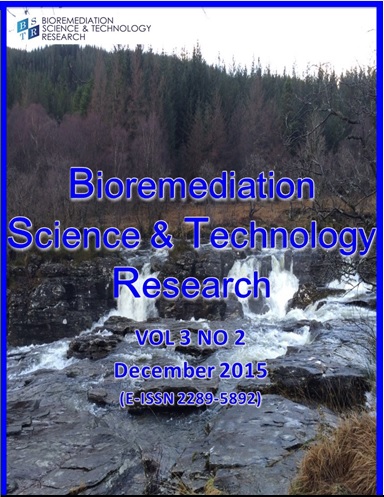<i>Bacillus thuringiensis</i> subsp. Entomocidus HD9 Cry1Ba4 insecticidal crystal protein: In-silico mutation, cloning, expression, mutation and domain I functional study
DOI:
https://doi.org/10.54987/bstr.v3i2.296Keywords:
Bacillus thuringiensis, Polymerase Chain Reaction, site- directed mutagenesis, Cry 1Ba4 protein, Plutella xylostella, homology modellingAbstract
The 3D structure of the insecticidal protein Cry1Ba4 produced by B. thuringiensis subsp. Entomocidus HD-9 was determined using homology modelling. From the model built, we have been able to identify the possible sites for structure modification by site-directed mutagenesis. The mutation was introduced at the conserved region of α-helix 7 by substituting the hydrophobic motif that comprises alanine 216, leucine 217 and phenylalanine 218 with arginine. Wild and mutant Cry1Ba4 genes were cloned into pET200/D-TOPO and expressed in the expression host. The result suggests that mutant Cry1Ba4 protein was less toxic to the larvae Plutella xylostella compared to the wild-type. In conclusion, alteration in the structure of Domain I had left an impact on the toxicity of Cry1Ba4 against P. xylostella.References
Schnepf, E., Crickmore, N., Van Rie, J., Lereclus, D., Baum, J., Feitelson, J., Zeigler, D. R. & Dean, D. H. Bacillus thuringiensis and its pesticidal crystal protein. Microbiol Mol Biol Rev. 1998:62, 775 – 806.
Hoffman, C.H., Vanderbruggen, H., Hofte, J., Van Rie, S., Jansen, and Van Mellaert, H. Specificity of Bacillus thuringiensis delta-endotoxin is correlated with the presence of high–affinity binding sites in the brush border membrane of target insect midgets. Proc. Natl. Acad. Sci USA. 1998:85, 7844 – 7848
Aronson, A.I., Wu, D., and Zhang, C. Mutagenesis of specificity and toxicity regions of a Bacillus thuringiensis protoxin gene. J. Bacteriol. 1995:177, 4059-4065.
Gazit, E., and Shai, Y. Structural and functional characterization of the alpha-5 segment of Bacillus thuringiensis delta-endotoxin. Biochemistry. 1993:32, 3429-3436
Knowles, B.H., Ellar, D.J., and Peter, J.K.K. N-acetyl-Galactosamine is part of the receptor in insect gut epithelia that recognizes an insecticidal protein from Bacillus thuringiensis. Biol Sci. 1991:Vol. 245, No. 1312, pp. 31-35
Crickmore, N.D.R., Zingler, J., Feitelson, E., Schnepf, J., Van Rie, D., Lereclus, J., Baum. and Dean, D.H. Revision of the nomenclature for the Bacillus thuringiensis pesticidal crystal protein. Mol Biol Rev. 1998:62 (3) , 807 – 810
Å ali, A., and Blundell, T.L. Comparative protein modelling by satisfaction of spatial restrains. J Mol Biol. 1993:234, 779-815.
Sánchez, R. and Šali, A. In: Protein Structure Prediction: Methods and Protocols. (Webster, D. M., ed). pp. 97-129. Humana Press. 2000.
Laemmli, U.K.. Cleavage of structural proteins during the assembly of the head of bacteriophage T4. Nature. 1970:227 (5259), 680–685.
Rajamohan, F., Cotrill, J.F., and Dean, D.H. Role of Domain II, loop 2 of Bacillus thuringienis CryIAb delta-endotoxin in reversible and irreversible binding to Manduca sexta & Heliothis virescens. J Biol Chem. 1996:271, 2390 – 2396.
Segura, C. F., Guzman, M., Patarroyo, S., Orduz. Activation pattern and toxicity of the Cry11Bb1 toxin of Bacillus thuringiensis subsp. medellin. J Invertebr Pathol. 2000:76, 56-62
Gazit, E., La Rocca, P., Sansom, M.S.P., Shai, Y. The structure and organization within the membrane of the helices composing the pore forming domain of Bacillus thuringiensis delta-endotoxin are consistent with an "umbrella-like" structure of the pore. Proc Natl Acad Sci USA. 1998:95, 12289-12294.
Kumar, A.S.M., Aronson, A.I. Analysis of mutations in the pore-forming region essential for insecticidal activity of a Bacillus thuringiensis delta-endotoxin. J Bacteriol. 1999:181, 6103-6107.
Chandra, A., Ghosh P., Mandokar, A.D., Bera, A.K., Sharma, R.P., Das, S. and Kumar, P.A. Amino acid substitution in α-helix 7 of Cry1Ac delta-endotoxin of Bacillus thuringiensis leads to enhanced toxicity to Helicoverpa armigera Hubner. FEBS Letters. 1999:458, 175-178.
Downloads
Published
How to Cite
Issue
Section
License
Authors who publish with this journal agree to the following terms:
- Authors retain copyright and grant the journal right of first publication with the work simultaneously licensed under a Creative Commons Attribution License (http://creativecommons.org/licenses/by/4.0) that allows others to share the work with an acknowledgement of the work's authorship and initial publication in this journal.
- Authors are able to enter into separate, additional contractual arrangements for the non-exclusive distribution of the journal's published version of the work (e.g., post it to an institutional repository or publish it in a book), with an acknowledgement of its initial publication in this journal.
- Authors are permitted and encouraged to post their work online (e.g., in institutional repositories or on their website) prior to and during the submission process, as it can lead to productive exchanges, as well as earlier and greater citation of published work (See The Effect of Open Access).


